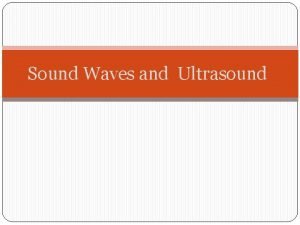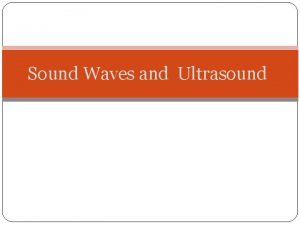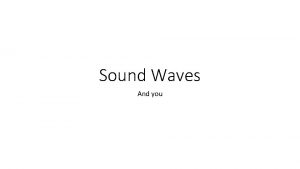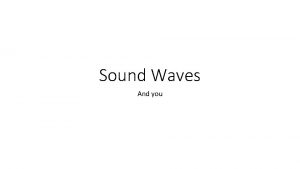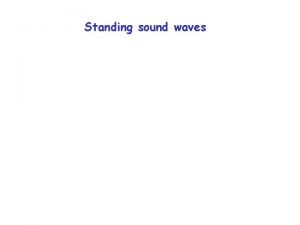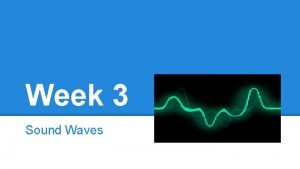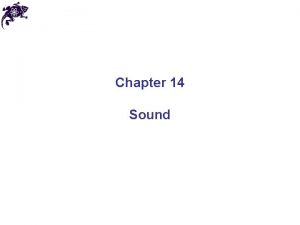Sound Sound Waves The origin of any sound












- Slides: 12

Sound

Sound Waves • The origin of any sound is a vibrating object – Usually the frequency of the sound is the same as that of the vibrating object • Frequency Range: Sound: 20 Hz – 20, 000 Hz Ultrasound: >20, 000 Hz Infrasound: < 20 Hz

Forced Vibration & Resonance • forced vibration – example -- strike tuning fork and hold the stem against the table • sounding board -- used to amplify sound in music boxes and all string • resonance -- when the frequency of forced vibrations matches the object's natural frequency, a dramatic increase in amplitude occurs

Speed of Sound • depends on wind conditions, temperature, and humidity • does NOT depend on loudness or frequency of the sound • all sounds travel at the same speed in the same medium in dry air at 0°C ~ 330 m/s (1200 km/h) • Sound travels faster through warm air than cold air. • In air, vsound = 330 m/s + (0. 6 m/s/Co)*TC

Pitch & Loudness • Pitch – frequency Double frequency – go up an octave • Loudness – amplitude

Decibel Scale • incredibly sensitive c i m h t i r a g • can hear everything from lo s i e l a fingertip brushing lightly c S l over fabric to a loud jet Decibe engine • sound of jet engine is about 1012 times more powerful than smallest audible sound • a big difference! • decibel scale -- smallest audible sound is 0 d. B • A sound 10 times more powerful is 10 d. B • A sound 100 times more powerful than near total silence is 20 d. B

Decibel Levels • • Near total silence - 0 d. B A whisper - 15 d. B Normal conversation - 60 d. B A lawnmower - 90 d. B A car horn - 110 d. B A rock concert or a jet engine - 120 d. B A gunshot or firecracker - 140 d. B

Waves Moving in and Out of Phase • When the 2 waves are in phase, the resulting disturbance has a maximum amplitude. • When the 2 waves are out of phase, the resulting disturbance has a minimum amplitude.

Beats • Waves of slightly different frequencies form a pattern of alternating maximum and minimum amplitude. • The packets of maximum amplitude are called beats.

Noise Canceling • tiny microphones, one on each earpiece, detect ambient noise before it gets to your ears. • noise-cancellation circuitry inverts the captured signal, turning the noise's sound wave upside down. • noise-cancellation system adds the sonic opposite of the external noise to whatever you're listening to • eliminating most of the pollution and leaving you with just your music.

Standing Waves • http: //phet. colorado. edu

Fundamental & Harmonics
 Characteristics of a longitudinal wave
Characteristics of a longitudinal wave Whats a reflected sound wave
Whats a reflected sound wave Electromagnetic waves are longitudinal waves true or false
Electromagnetic waves are longitudinal waves true or false What is a rainbow
What is a rainbow Compare and contrast p waves and s waves using venn diagram
Compare and contrast p waves and s waves using venn diagram A matter in which waves can travel and transfer energy
A matter in which waves can travel and transfer energy Mechanical and electromagnetic waves similarities
Mechanical and electromagnetic waves similarities What do all waves transmit
What do all waves transmit What is a semiconductor used for
What is a semiconductor used for Seismic waves
Seismic waves Constructive
Constructive Mechanical waves and electromagnetic waves similarities
Mechanical waves and electromagnetic waves similarities Is a seismic wave mechanical or electromagnetic
Is a seismic wave mechanical or electromagnetic














